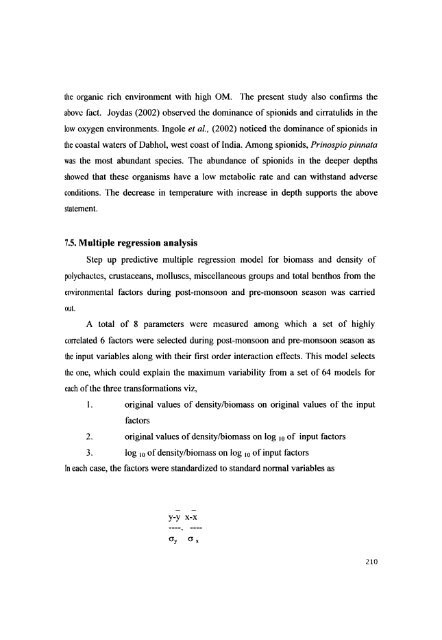L - Cochin University of Science and Technology
L - Cochin University of Science and Technology
L - Cochin University of Science and Technology
You also want an ePaper? Increase the reach of your titles
YUMPU automatically turns print PDFs into web optimized ePapers that Google loves.
the organic rich environment with high OM. The present study also confinns the<br />
above fact. Joydas (2002) observed the dominance <strong>of</strong> spionids <strong>and</strong> cirratulids in the<br />
low oxygen environments. Ingole et al., (2002) noticed the dominance <strong>of</strong> spionids in<br />
the coastal waters <strong>of</strong> Dabhol, west coast <strong>of</strong> India. Among spionids, Prinospio pinnata<br />
was the most abundant species. The abundance <strong>of</strong> spionids in the deeper depths<br />
showed that these organisms have a low metabolic rate <strong>and</strong> can withst<strong>and</strong> adverse<br />
conditions. The decrease in temperature with increase in depth supports the above<br />
statement.<br />
7.5. Multiple regression analysis<br />
Step up predictive multiple regression model for biomass <strong>and</strong> density <strong>of</strong><br />
polychaetes, crustaceans, molluscs, miscellaneous groups <strong>and</strong> total benthos from the<br />
environmental factors during post-monsoon <strong>and</strong> pre-monsoon season was carried<br />
out.<br />
A total <strong>of</strong> 8 parameters were measured among which a set <strong>of</strong> highly<br />
correlated 6 factors were selected during post-m on soon <strong>and</strong> pre-monsoon season as<br />
the input variables along with their first order interaction effects. This model selects<br />
the one, which could explain the maximum variability from a set <strong>of</strong> 64 models for<br />
each <strong>of</strong> the three transfonnations viz,<br />
1. original values <strong>of</strong> densitylbiomass on original values <strong>of</strong> the input<br />
factors<br />
2. original values <strong>of</strong> density/biomass on log 10 <strong>of</strong> input factors<br />
3. log 10 <strong>of</strong> density/biomass on log 10 <strong>of</strong> input factors<br />
In each case, the factors were st<strong>and</strong>ardized to st<strong>and</strong>ard nonnal variables as<br />
y-y x-x<br />
210

















